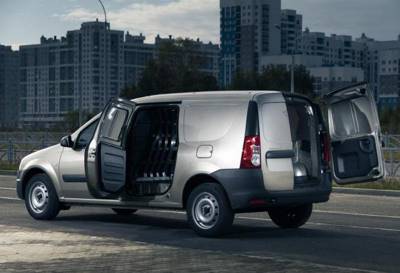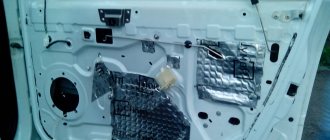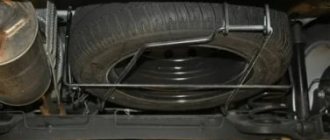LADA Largus has long won the sympathy of Russian car enthusiasts. Drivers often pay attention to the large trunk volume of the Lada Largus, which is considered the main advantage of this car. Domestic cars also cope well with another task - providing inexpensive and comfortable travel on modern roads. These two aspects and the ability to accommodate a large number of passengers allowed the car, produced at the Russian AvtoVAZ, to become a popular model in the CIS countries.
- station wagon,
- van,
- minivan.
Each car variation has its own luggage compartment volume. In a station wagon designed for 5 seats, the volume of this compartment is 700 liters. But the owner of this model can transport a large load. In the Lada Largus station wagon, the trunk volume can be increased to 1500–1800 liters by removing the second row of seats - a three-seater sofa. With the seats folded down, the station wagon's luggage compartment volume increases to 2,350 liters.

Linear dimensions of the cargo compartment of the Lada Largus van
All the sizes you need to know are shown in the photo. The van doors here are fixed at an angle of 90 degrees, but they can be opened all the way to 180. They are fixed in either of the two positions.

Luggage compartment of a Largus van
Let's list everything that is marked in the figure:
- The greatest height of the opening is 92 cm;
- Opening width – 108 cm;
- The distance “from arch to arch” is 96 cm;
- The distance from the edge of the threshold to the partition is 194 cm.
If you lay sheets diagonally, the width of the sheet should be less than 130 cm.
When the partition remains in place, the internal volume of the Lada Largus van is 2540 liters. Load capacity is 725 kg. These figures are indicated by AvtoVAZ.
In fact, the maximum lifting capacity exceeds a ton. It all depends on the road conditions and driving style.
F90
The Largus van has the largest trunk dimensions. In this variation of the car there is no back row of seats, and sometimes even two, and the body is elongated. Officially, the van's trunk capacity is 2,500 liters. The main task of the model is to transport goods, so there are no additional components or elements inside the body.
The van has a reinforced suspension, as this model is designed for transporting large cargo. Station wagons do not have this option.

Unfasten the partition or part of it
The partition separating the body and the cabin consists of two halves. They can be removed separately. Both parts are screwed to the body with screws designed for a 13mm key size. Of course, you need a socket wrench.

Screws 1 were hidden under the casing
The four screws on the left and right are located on the cab side. And to unscrew them, remove the casing.
All actions with cladding
The left part of the septum is removed after the right. To remove only the left half, first remove both, and then mount the right sash back. Based on this, immediately decide where you will remove the trim - only on the right or on both sides.
The volume of the body on the Lada Largus van cannot be greatly increased, even if the partition is completely removed. But without the partition, by removing the seat, it will be possible to transport loads 3 meters long.
So, let's start dismantling the trim: you need to remove the seat belt (key “17”), and then unscrew one self-tapping screw. A Torx T20 wrench is suitable for the self-tapping screw.
Lada Largus - technical specifications
Lada Largus can be purchased with one of the presented engines. Both power units are naturally aspirated with fairly good dynamics. Fuel consumption is average for its class. The suspension is also good. The rear is semi-independent, spring with hydraulic telescopic shock absorbers. The front is independent, MacPherson spring type. It has good settings, which ensures energy consumption, as well as stability on the road.
1.6 (87 hp) - gasoline, naturally aspirated, in-line 4-cylinder with 2 valves per cylinder. The maximum torque is 140 Nm at 3800 rpm. Acceleration to 100 km/h is carried out in 15.4 seconds. Even the 5-speed manual transmission does not help the dynamics. With this engine, the car is more suitable for quiet city driving.
1.6 (102 hp) - gasoline, naturally aspirated, in-line 4-cylinder with 4 valves per cylinder. The maximum torque is already 145 Nm at 3750 rpm. Acceleration to 100 km/h in combination with a manual transmission takes 13.5 seconds.
More details about the technical characteristics of the Lada Largus in the table below:
| Technical characteristics of Lada Largus | ||
| Engine | 1.6 MT 87 hp (5 places) | 1.6 MT 102 hp (5 places) |
| general information | ||
| Brand country | Russia | |
| Car class | WITH | |
| Number of doors | 5 | |
| Number of seats | 5,7 | |
| Performance indicators | ||
| Maximum speed, km/h | 155 | 165 |
| Acceleration to 100 km/h, s | 15.4 | 13.5 |
| Fuel consumption, l city/highway/mixed | 10.6/6.7/8.2 | 10.1/6.7/7.9 |
| Fuel brand | AI-95 | AI-95 |
| Environmental class | — | — |
| CO2 emissions, g/km | — | — |
| Engine | ||
| engine's type | petrol | petrol |
| Engine location | anterior, transverse | anterior, transverse |
| Engine volume, cm³ | 1598 | 1598 |
| Boost type | No | No |
| Maximum power, hp/kW at rpm | 87 / 64 at 5100 | 102 / 75 at 5750 |
| Maximum torque, N*m at rpm | 140 at 3800 | 145 at 3750 |
| Cylinder arrangement | in-line | in-line |
| Number of cylinders | 4 | 4 |
| Number of valves per cylinder | 2 | 4 |
| Engine power system | distributed injection (multipoint) | |
| Compression ratio | 10.3 | 9.8 |
| Cylinder diameter and piston stroke, mm | 82 × 75.6 | 79.5 × 80.5 |
| Transmission | ||
| Transmission | Mechanics | Mechanics |
| Number of gears | 5 | 5 |
| type of drive | front | front |
| Dimensions in mm | ||
| Length | 4470 | |
| Width | 1750 | |
| Height | 1636 | |
| Wheelbase | 2905 | |
| Clearance | 145 | |
| Front track width | 1469 | |
| Rear track width | 1466 | |
| Wheel sizes | 185/65/R15 | |
| Volume and mass | ||
| Fuel tank volume, l | 50 | |
| Curb weight, kg | 1330 | 1330 |
| Total weight, kg | 1810 | 1810 |
| Trunk volume min/max, l | 560/2350 | |
| Suspension and brakes | ||
| Front suspension type | independent, spring | |
| Rear suspension type | semi-independent, spring | |
| Front brakes | ventilated disc | |
| Rear brakes | drums | |
Increasing the volume of the cargo compartment (removing the excess part on the floor)
The cargo compartment volume of the Lada Largus van can be increased. To do this, remove the floor covering.

There are two types of fasteners here
We will need special Torx keys, without which the screws cannot be unscrewed: Torx T30 and T40.
Study the picture carefully:
- T40 caps (2) are located at the corners, as well as on the line between the arches;
- The remaining screws (1) are designed for Torx T30 keys.
Removing the trim will be easy. And when you install it, make rubber gaskets. They are fixed to the ends of the frame so that the casing does not rust.
The removable floor (cladding) consists of two halves - left and right. First, according to tradition, the right one is removed.
Luggage compartment dimensions
Based on the above, we can conclude that the dimensions of the luggage compartment of any version of the Lada Largus are quite impressive. The general dimensions of this compartment for the models are as follows:
- the opening height is 920 mm,
- the opening width is 980 mm,
- the height of the luggage compartment to the ceiling is from 870 to 930 mm for universal models and up to 1000 mm for a van,
- trunk length is 480–1570 mm for station wagons up to the 3rd and 2nd row of seats,
- the length of the van's luggage compartment is 1800 mm to the dividing wall,
- luggage compartment width – 1000–1450 mm.

A little about the engine
We have already figured out what the Lada Largus car is. The dimensions of the interior and trunk, as noted above, are quite impressive. Passengers have enough space for a comfortable ride, and the volume of the rear compartment is sufficient to transport a ton of potatoes.
But will this car take away such a quantity of potatoes? We can safely say yes. The power unit is available to choose from:
- 1.6 (8 valves, 90 hp);
- 1.6 (16 valves, 105 hp).
Both the first and second options allow you to feel confident on the road. The 16-valve engine is more economical, despite the fact that it has 105 “horses”. Car enthusiasts choose it more often than others.
Let's sum it up
The owners today have gained considerable experience in using LADA Largus in various fields and industries. They all nod their heads contentedly when asked about the convenience and practicality of the trunk. On the Internet you will find only a limitless mass of positive reviews about this model.
The size of the trunk turned out to be sufficient for the car to effectively demonstrate its functionality and be able to take the lead from competitors “touching on their heels.” The manufacturer managed to competently and rationally arrange the body space, which allows the station wagon to effectively cope with large objects, demonstrating an enviable carrying capacity. We definitely note that we recommend purchasing this station wagon for those who have not yet found a real “hard worker” as a companion, possessing a full range of balanced consumer and technical properties.
Video review of the LADA Largus luggage compartment:
Manufactured Lada Largus cars are equipped with two types of engines - 8 and 16 valves. Even in the basic configuration, the car is equipped with an airbag, a single integrated key that not only turns on the ignition, but also controls the doors and trunk lid, which is certainly convenient for a potential buyer. The engines comply with exhaust gas standards in accordance with Euro 4.
The assembled dimensions of the Lada Largus trunk are simply impressive. Its volume is 560 liters with the rear row seats folded.
The curb weight of the Lada Largus without a driver and luggage, depending on the type, ranges from 1186 to 1294 kilograms, the payload is from 515 to 555 kilograms, for a van - 800 kilograms.
The manufacturer has announced the following color options for this car model. The passenger station wagon can be painted in colors such as metallic (Basalt Gray, Diplomat, Phoenix Platinum, Cashmere, Centaur and Venus), as well as glacial. When releasing batches of taxis, a yellow color is possible. The vans, in addition to glacial and several metallic options, are also available in sea and ruby colors.
On a regular Lada Largus van, the body dimensions are selected so that Euro pallets can be transported. We are talking not only about the space between the pillars, which are spaced 108 cm apart, but also about the distance between the wheel arches. It is 96 cm, and one pallet takes 80. The distance from the rear doors to the partition generally approaches two meters! A little more and it would have been possible to fit a couple of Euro pallets. Here we will look at how to remove the partition between the body and the cabin, and at the same time remove the inner bottom of the body. The first is needed for transporting long cargo, the second is also used for some reason.
We study the fastening of partitions and floors. Everything is shown in one video.
All the sizes you need to know are shown in the photo. The van doors here are fixed at an angle of 90 degrees, but they can be opened all the way to 180. They are fixed in either of the two positions.
Luggage compartment of a Largus van
Let's list everything that is marked in the figure:
- The greatest height of the opening is 92 cm;
- Opening width – 108 cm;
- The distance “from arch to arch” is 96 cm;
- The distance from the edge of the threshold to the partition is 194 cm.
If you lay sheets diagonally, the width of the sheet should be less than 130 cm.
When the partition remains in place, the internal volume of the Lada Largus van is 2540 liters. Load capacity is 725 kg. These figures are indicated by AvtoVAZ.
In fact, the maximum lifting capacity exceeds a ton. It all depends on the road conditions and driving style.
Checking the load capacity or 700 kg, and Largus didn’t even break a sweat!
Today Largus did his full job! Is 700 kg the limit for Largus?

This morning the Largus was loaded with parcels for mother Largus drivers all over Russia and delivered to transport companies!

They even wrapped it around the roof! Because the thresholds do not fit in length. In the end, I decided that I would remove the partition so that I could move the front passenger seat all the way back and put the sills on top. I can say that with the installed thresholds it has become much easier to secure a load on the roof!

But these were just flowers! Further more serious loads awaited Largus! Because we had to pick up 420 kg of towbars and another 100 kg of miscellaneous and varied items! Plus I’m 106 kg and my friend is 116, fully loaded we drove to the gym, and then I went to unload. Unfortunately, I took the photo of the drawdown when there was a 500 kg load in the cabin. With 700 kg, I didn’t think to ask anyone to take a photo. But there is still more to come!

And here are the photos of the drawdown! I made a mark on the box so that I could measure the difference after unloading.

Here you can see how much taller the Largus became after it “lightened”; through measurements it was calculated that with a load of 500 kg, the drawdown is 7 cm, from the wheel to the wing molding is 8 cm! But the wheel can still creep behind the wing, in theory, by a few centimeters.

I can say the following: with such weights, Largus lost a little in acceleration dynamics, but for me this is not important, because a van is a work machine, not a sports equipment! I found a couple of negatives in the van, which I will fix in the near future! These are limit switches, or rather their absence in the rear doors! Firstly, the signaling system does not really understand whether they have been opened or not, and secondly, when unloading through the side doors, the interior lighting goes out, because the light bulb does not see the open doors. The second minus is the luggage compartment lighting itself! How can I put it more precisely... here it is!))) It creates twilight in the car, but I want normal visibility. Therefore, I’ll install limit switches and buy diodes or think about how to add another lamp. Among the minor inconveniences, I will highlight the following: there is a dead zone in the mirrors. I will think about installing additional hemispheres. I also want to tear down the partition and, if I have the money, replace the back door with a door with glass. Well, I’ll plug in the car pc and connect the rear view camera there. Perhaps after installing a rear view camera, the desire to change the door will disappear, but for now I am very sad about the lack of glazing. Here is a report for one day.














